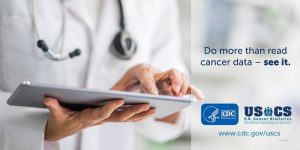Four Reasons Why You Should Use the US Cancer Statistics Tools
Posted on byMary Elizabeth O’Neil, MPH
CDC Epidemiologist
U.S. Cancer Statistics, the official federal cancer statistics covering the entire United States population, has been updated with new data and new ways to analyze the data by demographics and risk factors. Learn more about how you can explore and use the latest U.S. cancer data.

- Tailor the data to your research interests. Get a fast, easy look at a range of information from the number of new cases and deaths, rates and trends, to survival and prevalence estimates. You also can find out what’s going on in your county and congressional district.
- Do more than just read cancer data, see the data. The U.S. Cancer Statistics Data Visualizations Tool includes interactive graphics and text explaining the data. You can create trend graphs, maps, and tables by state, county, and demographic characteristics. You also can download presentation-ready images and shareable graphics designed for e-mail and social media sites.
- Get more cancer data in 2019. In addition to U.S. congressional district data released earlier this year, there are two new data modules. The Rate of New Cancers in American Indians and Alaska Natives module includes incidence data linked to Indian Health Services (IHS) patient registration data. The data are restricted to non-Hispanic populations residing in IHS purchased and referred care delivery area (PRCDA) counties, resulting in more precise cancer statistics for American Indian and Alaska Native populations. The Risk Factor-Associated Cancers module presents incidence data for cancers associated with tobacco use, alcohol use, human papillomavirus (HPV) infection, excess body weight, and physical inactivity.
- Go deeper with the public use database. Researchers can access and analyze high-quality, population-based cancer incidence data for the entire U.S. population, for free! The new U.S. Cancer Statistics Public Use Database has 26 million de-identified cases and spans 16 years. These facts are important for researchers because we want them to know we have a good span of data that allows for trend analyses, and the large number of cases allows researchers to look at rare cancers and at sub-populations, whether demographically or by cancer characteristics.
Cancer registry data are used to measure progress and target cancer prevention and control activities. You can use U.S. Cancer Statistics data to inform decision making, scientific inquiries, and program and policy development and evaluation. By using this rich data resource, you can positively affect comprehensive cancer prevention and control as well as the care and quality of lives for people diagnosed with cancer.
Posted on by

